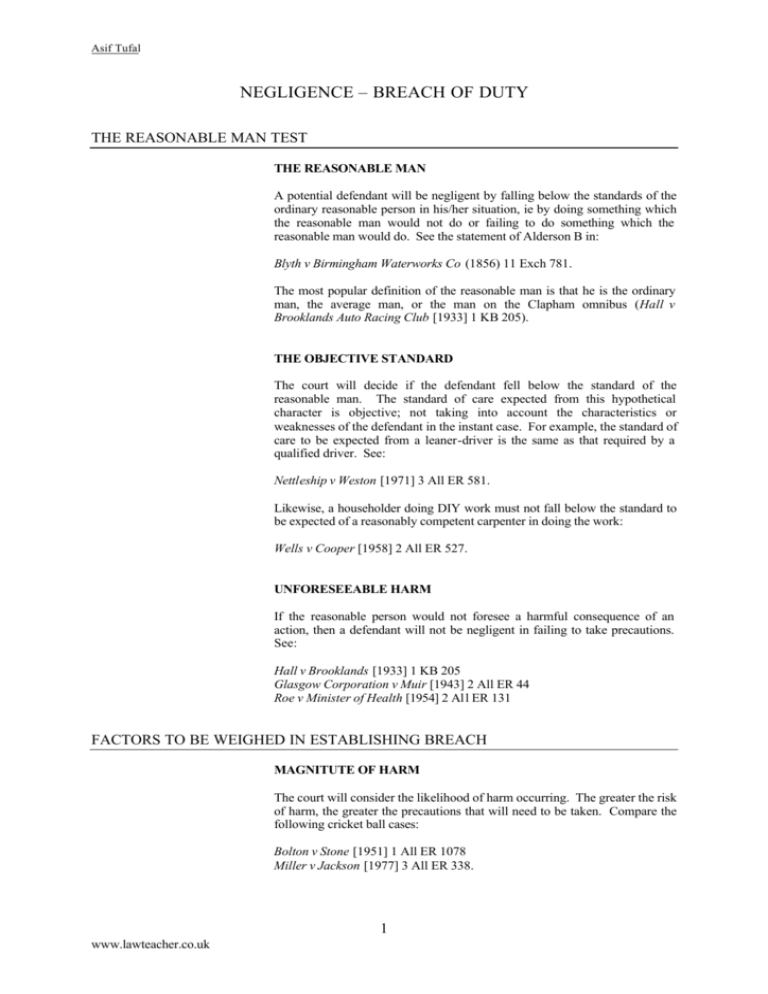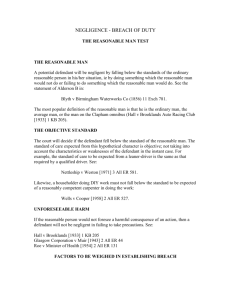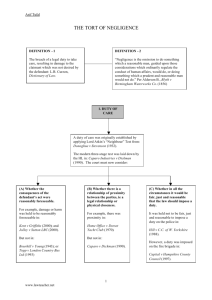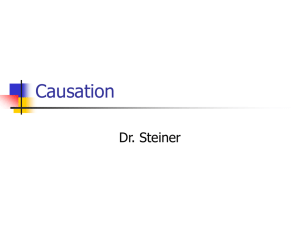Negligence breach
advertisement

Asif Tufal NEGLIGENCE – BREACH OF DUTY THE REASONABLE MAN TEST THE REASONABLE MAN A potential defendant will be negligent by falling below the standards of the ordinary reasonable person in his/her situation, ie by doing something which the reasonable man would not do or failing to do something which the reasonable man would do. See the statement of Alderson B in: Blyth v Birmingham Waterworks Co (1856) 11 Exch 781. The most popular definition of the reasonable man is that he is the ordinary man, the average man, or the man on the Clapham omnibus (Hall v Brooklands Auto Racing Club [1933] 1 KB 205). THE OBJECTIVE STANDARD The court will decide if the defendant fell below the standard of the reasonable man. The standard of care expected from this hypothetical character is objective; not taking into account the characteristics or weaknesses of the defendant in the instant case. For example, the standard of care to be expected from a leaner-driver is the same as that required by a qualified driver. See: Nettleship v Weston [1971] 3 All ER 581. Likewise, a householder doing DIY work must not fall below the standard to be expected of a reasonably competent carpenter in doing the work: Wells v Cooper [1958] 2 All ER 527. UNFORESEEABLE HARM If the reasonable person would not foresee a harmful consequence of an action, then a defendant will not be negligent in failing to take precautions. See: Hall v Brooklands [1933] 1 KB 205 Glasgow Corporation v Muir [1943] 2 All ER 44 Roe v Minister of Health [1954] 2 All ER 131 FACTORS TO BE WEIGHED IN ESTABLISHING BREACH MAGNITUTE OF HARM The court will consider the likelihood of harm occurring. The greater the risk of harm, the greater the precautions that will need to be taken. Compare the following cricket ball cases: Bolton v Stone [1951] 1 All ER 1078 Miller v Jackson [1977] 3 All ER 338. 1 www.lawteacher.co.uk Asif Tufal Consider the following question: ‘What is the possibility of harm being caused by road works to a blind pedestrian?’ See: Haley v London Electricity Board [1964] 3 All ER 185. Sometimes, the risk of harm may be low but this will be counter-balanced by the gravity of harm to a particularly vulnerable claimant. See: Paris v Stepney Borough Council [1951] 1 All ER 42. DEFENDANT’S PURPOSE If the defendant’s actions serve d a socially useful purpose then he may have been justified in taking greater risks. See: Daborn v Bath Tramways [1946] 2 All ER 333 Watt v Hertfordshire County Council [1954] 2 All ER 368. PRACTICABILITY OF PRECAUTIONS The courts expect people to take only reasonable precautions in guarding against harm to others. See: Latimer v AEC Ltd [1952] 1 All ER 1302. GENERAL PRACTICE If the defendant acted in accordance with the common practice of others this will be strong evidence that he has not been negligent. For example, see: Gray v Stead [1999] 2 Lloyd’s Rep 559. However, this will not prevent the courts from declaring a common practice to be negligent in itself ( Paris v Stepney BC [1951] 1 All ER 42). SPECIAL STANDARDS APPROPRIATE TO PROFESSIONALS Professionals will be judged by the standard of the ordinary skilled man exercising and professing to have that special skill. This is the basis of the ‘Bolam test’. See: Bolam v Friern Hospital [1957] 2 All ER 118. Other cases relevant to professionals, doctors in particular, include: Sidaway v Bethlem Royal Hospital [1985] 1 All ER 643 Bolitho v City and Hackney Health Authority [1997] 4 All ER 771. People holding themselves out as having a specialist skill will be judged by the standards of a reasonably competent man exercising that skill. See: Philips v William Whiteley [1938] 1 All ER 566 Wilsher v Essex Area Health Authority [1986] 3 All ER 801 (overruled on the issue of causation in [1988] 1 All ER 871, and a retrial ordered). 2 www.lawteacher.co.uk Asif Tufal STANDARD APPLIED IN SPORTING SITUATIONS Spectators at a sporting event take the risk of any injury from competitors acting in the course of play, unless the competitor’s actions show a reckless disregard for the spectator’s safety. See: Woolridge v Sumner [1962] 2 All ER 978. Participants in sport owe a duty of care to each other which can be breached as in: Condon v Basi [1985] 2 All ER 453. A referee who oversees a match may also owe a duty of care to see that players are not injured: Smoldon v Whitworth [1997]. STANDARD APPLIED TO CHILDREN Children cannot plead infancy as a defence to a tort. However, children and young people will usually be judge by the objective standard of the ordinarily prudent and reasonable child of the same age. See: Mullins v Richards [1998] 1 All ER 920 If a young person deliberately commits an action with an obvious risk of harm, they may be judged by the standards of an adult. See: Williams v Humphrey, The Times, February 20 1975. Alternatively, school authorities or parents, may be liable in negligence for failing to adequately supervise a child who causes harm to another. See: Carmarthenshire County Council v Lewis [1955] 1 All ER 565 Barnes v Hampshire County Council [1969] 3 All ER 746 3 www.lawteacher.co.uk Asif Tufal PROOF OF NEGLIGENCE IMPORTANCE OF EVIDENCE IN ESTABLISHING PROOF OF BREACH The claimant bears the burden of proving, on the balance of probabilities, that the defendant was negligent. However, in some situations a claimant may be able to rely on the maxim res ipsa loquitur, i.e. the thing speaks for itself. By this rule of evidence, the mere fact of an accident occurring raises the inference of the defendant’s negligence, so that a prima facie case exists. “You may presume negligence from the mere fact that it happens” (Ballard v North British Railway (1923) SC 43). WHEN THE MAXIM ‘RES IPSA LOQUITUR’ APPLIES There are three conditions that must be fulfilled before res ipsa loquitur applies. (a) The defendant must have control over the thing that caused the damage. See: Easson v LNER [1944] 2 All ER 425 (b) The accident must be such as would not normally happen without carelessness. See: Scott v London and St Katherine Docks (1865) 3 H & C 596 (c) The cause of the accident must be unknown. See: Barkway v South Wales Transport [1950] 1 All ER 392 ITS EFFECT There are two opinions as to the effect of res ipsa loquitur. (a) It raises a prima facie inference of negligence, which requires the defendant to provide a reasonable explanation of how the accident could have occurred without negligence on his part. If the defendant provides an explanation, the inference is rebutted and the claimant must prove the defendant’s negligence. See: Colvilles Ltd v Devine [1969] 2 All ER 53 (b) It reverses the burden of proof requiring the defendant to show that the damage was not caused by his failure to take reasonable care. See: Henderson v Henry Jenkins & Sons [1969] 3 All ER 756 Ward v Tesco Stores [1976] 1 All ER 219 The opinion of the Privy Council is that burden of proof does not shift to the defendant because the burden of proving negligence rests throughout the case on the claimant. See: Ng Chun Pui v Lee Chuen Tat [1988] RTR 298. 4 www.lawteacher.co.uk










